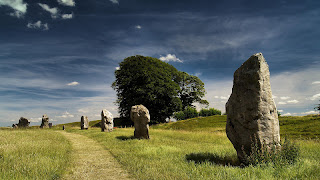The Avebury ring is the oldest stone ring that is known to be in existence anywhere in the world and is even older than Stonehenge. The stone circle at Avebury is bigger (16 times the size), less touristy, and, for many, more interesting than Stonehenge. You’re free to wander among 100 stones, ditches, mounds, and curious patterns from the past, as well as the village of Avebury, which grew up in the middle of this fascinating, 1,400-foot-wide neolithic circle.
The large circle contains a grass bank that measures about 427m in diameter and reaches as high as six meters. Within the grass area is an inner ditch that can be entered via four entrances at each of the points on a cardinal compass.
After passing through the ditch visitors come upon a large circle of sarsen stones that wrap around about 28 acres of land. It is thought that the circle must have originally contained about 98 stones in order to complete the circle, but all that is remaining to the present day are 27 stones.
Within the circle of massive stones are two smaller stone circles that sit inside the centre of the Avebury ring. One is located in the Northern sector of the Avebury ring and there are four of the 27 stones left today. The other is in the Southern sector of the ring and has five or the original 29 stones still standing. In the 14th century, in a kind of frenzy of religious paranoia, Avebury villagers buried many of these mysterious pagan stones. Their 18th-century descendants hosted social events in which they broke up the remaining pagan stones (topple, heat up, douse with cold water, and scavenge broken stones as building blocks). In modern times, the buried stones were dug up and re-erected. Concrete markers show where the missing broken-up stones once stood.
It is speculated that the inner circles were created first in about 2600BC while the outer circle and ditch were created later in 2500BC.
Each of the stones is suspected to weigh upwards of 40 tons with heights that measure over twenty feet thus implying that the local inhabitants must have worked together in order to complete the Avebury Ring. Additionally, each stone was placed into holes in the earth that measured anywhere between six and 24 inches.
The ditch also would have required a large amount of effort to form with the need to chop away about 200,000 tons of rocks. There are also some remnants of erosion that suggest the ditch may have at one time been filled up with water making the stone rings appear to be sitting on an island.
Excavation studies have shown that there were 154 stones total when the Avebury ring was first built out of which 36 total are still standing.
There are three theories about why the stones may have been removed, the first two have to do with modernization in which the stones were moved so that crops could be planted and the rock could be used to build foundations of homes and shops. The third theory is that in the 14th century the stones may have been broken up by Christian authorities in an attempt to remove pagan religion from the area.
It is often speculated that the Avebury ring was part of a large serpent design that passed through a circle to form an alchemical symbol and that the area may have been part of a temple. Its exact use by ancient civilizations has not yet been fully understood.


0 comments:
Post a Comment